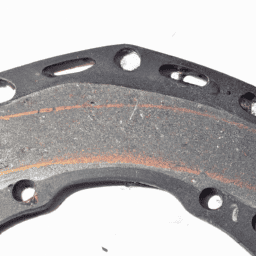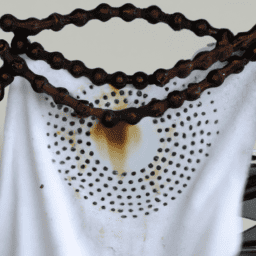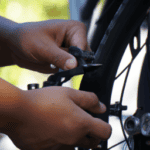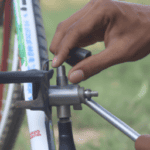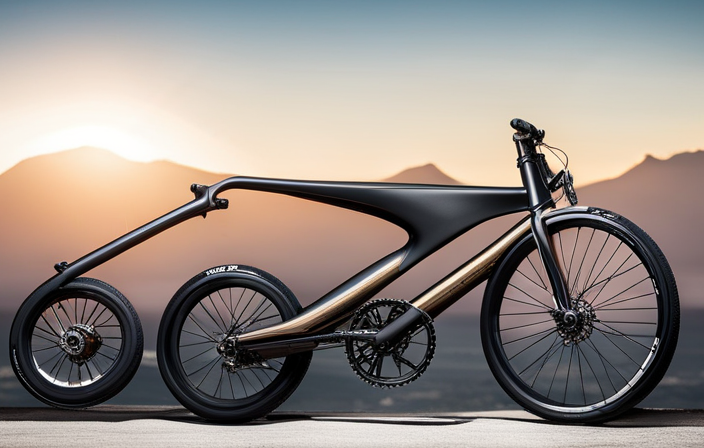As someone who is passionate about cycling, ensuring that my disc brake pads are in proper working condition stands out as a crucial part of maintaining my bike. However, the question arises: What is the lifespan of these brake pads before there’s a need for replacement?
Well, the answer is that it depends on several factors, including the type of riding you do, the condition of your brake rotors, and the quality of your brake pads.
Firstly, the type of riding you do can greatly affect the longevity of your disc brake pads. If you’re a mountain biker who frequently rides on steep terrain with lots of sharp turns and sudden stops, your brake pads will likely wear out more quickly than someone who primarily uses their bike for commuting or leisurely rides.
Additionally, the condition of your brake rotors can also play a role in how long your brake pads last. If your rotors are warped or damaged in any way, they can cause your brake pads to wear unevenly or even become unusable.
Lastly, the quality of your brake pads can also impact their longevity. Higher quality brake pads tend to last longer and provide better stopping power than cheaper, lower quality options.
Key Takeaways
- Factors affecting disc brake pad longevity include riding type, brake rotor condition, pad quality, frequency of riding, terrain, and environmental conditions.
- Signs of wear and tear include squealing or grinding sounds, soft or spongy brakes, vibration or shaking, reduced stopping power, and visible wear on pads.
- To extend pad life, regular cleaning of rotors and pads, using correct pads for bike type, following proper installation and maintenance techniques, avoiding harsh braking and using gears to control speed, riding on flat, smooth surfaces, riding in dry and cooler weather, and properly adjusted brakes are recommended.
- When replacing worn pads, it is important to align them properly and follow the manufacturer’s instructions. Regular inspection of the brake system and addressing issues promptly is crucial for optimal performance and safety.
Factors Affecting Disc Brake Pad Longevity
You might be wondering, "How long do my bicycle disc brake pads last?"Well, the answer depends on a number of factors.
One of the biggest factors is how often you ride your bike. The more you ride, the faster your brake pads will wear down.
Additionally, the terrain you ride on can have a big impact on the longevity of your brake pads. If you frequently ride on steep hills or rough terrain, your pads will wear down more quickly than if you primarily ride on flat, smooth surfaces.
Another factor that can affect the lifespan of your brake pads is environmental conditions. If you frequently ride in wet or muddy conditions, your brake pads will wear down more quickly than if you primarily ride in dry weather. Similarly, if you ride in very hot conditions, your brake pads may wear down faster than if you typically ride in cooler weather.
All of these factors can impact the life of your brake pads, so it’s important to be aware of them when determining how long your pads will last.
Now, let’s discuss some signs that your disc brake pads need replacement.
Signs That Your Disc Brake Pads Need Replacement
If your brakes are making a squealing or grinding sound, it may be time to replace your disc brake pads. These sounds are often an indication that the pads have reached the end of their lifespan and are no longer effective. Common wear can be caused by a variety of factors, such as the type of riding you do, the terrain you ride on, and your braking habits.
To help you identify when it’s time to replace your disc brake pads, I’ve created a table below that outlines some common signs of wear and tear. Keep in mind that regular maintenance measures, such as cleaning your rotors and pads, can help extend the life of your brake pads. By staying vigilant and addressing any issues as soon as they arise, you can ensure that your bike’s braking system stays in top condition.
| Signs of Wear and Tear | What It Means |
|---|---|
| Squealing or Grinding Sounds | Pads have worn down, and metal is now grinding against metal. |
| Soft or Spongy Brakes | Air has entered the hydraulic system, or the pads are contaminated. |
| Vibration or Shaking | Warped or damaged rotors, or uneven wear on the pads. |
| Reduced Stopping Power | Pads have worn down and no longer make sufficient contact with the rotor. |
| Visible Wear on Pads | Pads have become thin or uneven due to extended use. |
In order to prevent premature wear and tear on your disc brake pads, there are several tips you can follow to extend their lifespan. From avoiding harsh braking to regularly inspecting your brake system, the next section will cover some helpful tips for keeping your brake pads in top condition.
Tips for Extending the Life of Your Disc Brake Pads
As a cyclist, I’ve found that one of the most important things to remember when it comes to extending the life of my disc brake pads is to avoid overheating them.
This means not riding the brakes down long descents and instead using a combination of braking and feathering.
Another key tip I’ve learned is to regularly clean my rotors to prevent buildup of debris and other materials that can cause premature wear on the pads.
Lastly, it’s essential to use the correct pads for your specific brake system to ensure optimal performance and longevity.
By keeping these tips in mind, you can save money on frequent pad replacements and enjoy a safer, more enjoyable ride.
Avoid Overheating
When your bicycle disc brake pads get too hot, they can melt like butter in a frying pan. This can be dangerous, as it can cause your brakes to fail when you need them the most. Preventing overheating is key to keeping your disc brake pads in good condition. Proper maintenance techniques can help you avoid this problem.
One of the best ways to prevent overheating is to use your brakes properly. Avoid using your brakes constantly, especially when going downhill. This can cause your brakes to heat up quickly, which can lead to melting. Instead, try to use your brakes intermittently, and use your gears to control your speed. Additionally, make sure that your brakes are properly adjusted, as this can also affect how quickly they heat up. By taking these precautions, you can help ensure that your disc brake pads last as long as possible.
| What Causes Overheating? | How to Prevent Overheating? | What to Do if Overheating Occurs? |
|---|---|---|
| Excessive braking | Use brakes intermittently and properly | Stop and wait for brakes to cool down |
| Riding downhill for extended periods | Use gears to control speed | Avoid using brakes excessively after overheating |
| Improper brake adjustment | Have brakes properly adjusted | Replace brake pads if they have melted or become damaged |
Now, that you know how to prevent overheating, it is important to clean your rotors to keep your brakes functioning properly.
Clean Your Rotors
Properly cleaning your rotors is essential to maintain the performance and longevity of your bike’s braking system. Over time, dirt, oil, and other debris can accumulate on your rotors, causing them to become less effective. To avoid this, it’s important to clean your rotors regularly using appropriate techniques.
Here are some tips on how to effectively clean your bike’s rotors:
- Use a clean, dry cloth to wipe down your rotors after each ride.
- If your rotors are particularly dirty, use a degreaser or brake cleaner to remove any stubborn grime.
- Be careful not to spray cleaning solutions directly onto your brake pads, as this can cause them to become contaminated.
- Depending on your riding conditions, you should aim to clean your rotors at least once a month.
By following these cleaning techniques and maintaining a regular cleaning schedule, you can ensure that your bike’s braking system remains in top condition.
The next step in maintaining your bike’s disc brake system is to use the correct pads for your bike.
Use the Correct Pads
After cleaning your rotors, the next step to ensure the longevity of your disc brake pads is to use the correct pads for your bike. Using the wrong type of pad can cause premature wear and tear, and may even damage your rotors. It’s crucial to know what type of pads your bike needs and to use them accordingly.
Proper installation of the correct pads is also essential to ensure their longevity. It’s imperative to follow the manufacturer’s instructions to ensure that the pads are installed correctly. Additionally, regular maintenance techniques such as cleaning and inspecting the pads can help prolong their lifespan. By using the correct pads and following proper installation and maintenance techniques, you can ensure that your disc brake pads will last longer and perform optimally.
As we move on to the next section, it’s important to note that replacing your disc brake pads is not a daunting task. With the proper tools and techniques, you can replace your pads quickly and easily.
How to Replace Your Disc Brake Pads
First, you’ll need to gather the necessary tools and new brake pads before replacing your worn ones. Here are the steps on how to do it:
- First, remove the wheel from the bike and take out the retaining pin that holds the brake pads in place.
- Then, slide out the old brake pads and take note of their orientation and position.
- Clean the brake caliper and rotor with rubbing alcohol or brake cleaner to remove any debris or contaminants.
It’s important to note some common mistakes and troubleshooting when replacing your disc brake pads. One common mistake is not properly aligning the brake pads to the rotor, which can cause uneven wear and poor braking performance. To avoid this, make sure to align the brake pads properly and adjust the caliper if necessary.
If you’re having trouble with the brake pads rubbing or making noise, double-check the alignment and adjust as needed. With these steps and tips in mind, replacing your disc brake pads should be a breeze.
Frequently Asked Questions
Can I use any brand of disc brake pads on my bicycle or do I need to use the same brand as my brake system?
When choosing compatible brake pads for my bike, it’s important to consider the pros and cons of using different brand pads. While it’s possible to mix brands, it can affect performance and may void warranties.
How often should I check my disc brake pads for wear and tear?
I check my disc brake pads for wear and tear every few months. It’s important to properly install brake pads to ensure safety. Signs of wear beyond visual inspection include decreased braking power and unusual noises.
Can I replace just one disc brake pad or do I need to replace both at the same time?
When replacing individual pads on a bicycle disc brake system, it’s important to ensure brake pad compatibility. It’s recommended to replace both pads at the same time to maintain even wear and consistent braking performance.
What is the difference between organic and metallic disc brake pads and which should I choose?
When choosing between organic and metallic disc brake pads, consider the pros and cons of each. Organic pads offer better modulation and are quieter, but wear faster. Metallic pads have better heat dissipation and last longer, but can be noisier and can wear down rotors more quickly. Factors to consider when choosing the right pads for your bike include riding conditions, personal preference, and budget.
Are there any safety precautions I should take when replacing my disc brake pads?
When replacing disc brake pads, it’s important to follow proper handling techniques and dispose of old pads properly. Wear gloves to avoid contact with brake dust and consider using a respirator.
Conclusion
Well folks, it seems we’ve reached the end of our journey together, exploring the longevity of bicycle disc brake pads. We’ve learned about the various factors that can affect the lifespan of these crucial components, from the type of riding you do to the quality of the brake pads themselves.
We’ve also discussed the telltale signs that your brake pads might be on their last legs, as well as some tips for extending their life for as long as possible. But let’s be real here, folks. There’s only so much we can do to prolong the inevitable.
At some point, those brake pads are gonna wear out, and you’re gonna need to replace them. And if you’re anything like me, you’ll probably put it off for as long as possible, convincing yourself that the squealing and lack of stopping power is just a temporary fluke. But trust me, when you finally bite the bullet and replace those pads, you’ll wonder why you didn’t do it sooner.
So go forth, my fellow cyclists, and take care of those brakes. Your life may just depend on it.
